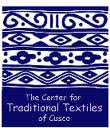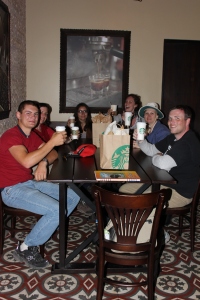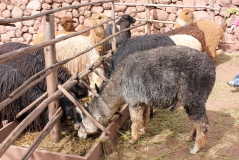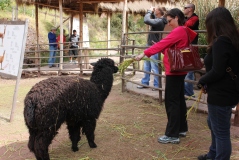Imperial Tomb Found in Peru
27 Jun 2013 Leave a comment
in Archaeology, History, Peru Tags: archeology, Peru, queens, tombs, Wari
¡Buen provecho!
11 Sep 2012 Leave a comment
in History, Peru Tags: food research, foodways, history of potatoes, Peru
Let’s talk about Peruvian cuisine!
If you remember, I am a food anthropologist. More specifically, an archaeobotanist, which is just a fancy way to say that I study the old, burnt seeds and plants that people ate in the past. I also love to try new foods and styles of preparation for foods I commonly eat. So, I am completely infatuated with how other people eat, what other people eat, and whom they eat with when I travel.
While visiting Peru, I learned much about their cuisine, both ancient and modern. In fact, our guides throughout the trip – Luis in Lima and Al and Victor in the Sacred Valley – often spoke about food traditions. The following information is based on what I learned listening to our guides talk while we rode the bus from one spectacular site to the next. Here is just a taste…
Did you know that there are more than 3000 varieties of potatoes indigenous to Peru, and more than 700 in Cusco alone?
Most Andean potatoes are vastly different from what we think of as a “normal” potato. They have skin and flesh that are often colored bright yellow or deep purple. Some varieties are long and thin, and others wrinkled. Many have a high nutritional quality and a strong potato-y taste. Many Peruvian varieties are less watery than common potatoes or have nut-like tastes and crisp textures. Moreover, most of these less recognized types of potatoes are adapted to marginal growing environments and possess considerable resistance to various troublesome diseases, insects, and frost1 .
There are many traditional dishes made from Peruvian potatoes, but one in particular stands out in my mind at this very moment. One afternoon at lunch my homestay “Mom” made a delicious vegetable soup. The star of the soup was a crisp fingerling potato that I have never tasted before. The texture and flavor were quite different from the potato varieties I have tasted before and very yummy!
Peruvian Potatoes & Indigenous Varietals. http://nissa.ger-nis.com/2010/10/07/peruvian-potatoes-indigenous-varietals/
Centro de Textiles Tradiccionales del Cusco
27 Aug 2012 1 Comment
in History, Inca, Peru Tags: Andean cosmology, Andean Culture, back looms, Cusco, Cusco textile museum, indigenous textile manufacture, Peru, waving, weaving as indigeous identity markers
Buenos Dias Peru-fans!
Well I am still pondering indigenous textile manufacture this week. Last time I shared our experience at Awanakancha in Pisac. This week I would like to tell you about the Textile museum we visited in downtown Cusco.
Team Jaguar (we adopted a name for our group while traveling, silly but fun) visited the Center for Traditional Textiles in Cusco on our last day there. It was our “free day,” a day where we had no set itinerary and could wander at will. The day itself was a refreshing break from our 10 days of rigidly scheduled travel. Don’t misunderstand me, it was important to stick to our tight schedule in order to see all the wonderful things Peru had to offer, however, after 10 days the free day felt extremely decadent.
The funniest thing was, that we all ended up finding each other anyway – at Starbuck’s 🙂 As a side note, we were desperate for a brewed cup of coffee by then. Shocking I know! All that wonderful specialty coffee grown in Peru that we purchase here in the U.S., at a premium, well they don’t actually drink it there. It is grown for export. Nescafe instant coffee is what is imbibed by the locals in their homes. Yuck, Yuck, Yuck – and as an anthropologist I should not judge others by my own standards – I know this in my soul – but really, Yuck, Yuck, Yuck! My coffee that morning brought a tear to my eye out of pure joy. I will never take my coffee pot at home for granted again, I promise.
Anyway, I digress. What I really wanted to talk about was the textile museum. I shall circle back around to the topic at hand.
We spent the day wandering around Cusco, exploring at our own pace. Pachamama (better known as Pam) had found the Museum earlier in the week and we decided to visit. We wandered through the exhibits learning about the history of textile manufacture in Cusco. Upon exiting the exhibit area we found ourselves in the museum shop (of course) but there were also a group of weavers sitting on the floor in a circle weaving textiles on their back looms. Even though I had already purchased a lovely textile for my home at Awanakancha, I, as well as the rest of Team Jaguar, managed to find a few more treasures to bring home with us from the Museum.
 Centro de Textiles Tradiccionales del Cusco
Centro de Textiles Tradiccionales del Cusco
Centro de Textiles Tradiccionales del Cusco is a non-profit organization founded in 1996 established to document ancient pre-columbian textile traditions. Their goal is to recapture the history of these traditions and spread information about the production of traditional textiles. The center also provides support to communities of weavers through research and documentation of weaving techniques, styles, and design. These textile traditions and practices date back thousands of years in are an important symbol of cultural identity. Weaving was and still is a form of communication with codes and figures that represent a textiles: place of origin, weaver who created it, and an artistic representation of Andean cosmology. The weaving patterns of each community differs in design, color schemes, and materials used. Each community has their own unique patterns that can be used as a marker of identity.
The center works with 9 communities in the Cusco area. Modern weavers still continue to create textiles by hand on belt or stake looms. Traditional dying methods use plants, insects, and minerals to dye the wool.
http://www.textilescusco.org/eng/index.html
Avenida Sol 603, Cusco-Peru (7/2/12)
“Vine of the Souls”
07 Aug 2012 5 Comments
in Archaeology, History, Inca, Peru Tags: ayahuasca, hallucinogen, Inca, Peru, shamanism, vine of souls
Sounds poetic doesn’t it?
As an anthropological archaeologist I am interested in shamanism both in ancient and modern cultures. Over the course of my readings, research, and travels I have noticed that almost all of the cultures I have studied have something that is used to cross between worlds or planes. It can be a fermented or distilled beverage, a hallucinogen, or even a botanical that is smoked. Examples include the Yanomamo using ebene, the Pohnpeians using kava, ancient Egyptians & Mesoamericans drinking beer, ancient Romans drinking wine. In Peru, both in ancient and modern times, it is Ayahuasca.
Mostly it is the shamans or priests that will use a mind or mood altering substance to do so, but it is not unheard of for the general population to commune with the spirits as well.
Ayahuasca
In Quechua Ayahuasca means spirit vine or vine of the souls. Ayahuasca is prepared by boiling the Caapi vine (Banisteriopsis caapi) along with the Chacuruna bush (Psychotria vidiris) to create a hallucinogenic liquid.1 Ayahuasca is used for religious purposes either by shamans or others under the supervision of a shaman. The psychedelic effects of ayahuasca include visual and auditory stimulation, the mixing of sensory modalities, and psychological introspection that may lead to great elation, fear, or illumination. Its purgative properties, known as la purga or “the purge” intense vomiting and occasional diarrhea. Indigenous people say that during their trance, which lasts approximately four hours, they enter the world of the spirits and communicate with them.
Our guide at Tambopata, Guido, explained his experiences while taking Ayahuasca. He talked about the intensive vomiting and the trance that follows. He believes he communed with Pachamama during his trances. At the lodge, one can request that the local shaman come perform the ayahuasca ritual with you for a nominal fee of $200.
1 The Ayahuasca. Sowewankeri Ayahuasca Healing Circle, Peru. http://ayahuascacircle.com/?page_id=6
Craven Community College, Study Abroad Peru, 2012 – YouTube
17 Jul 2012 2 Comments
in Archaeology, History, Inca, Peru Tags: Ballestas Isles, Cusco, Ica, Inca, Machu Picchu, Nazca, Peru, Puerto Maldonado
Hola Amigos! Check out this cool new video from our trip to Peru. One of our participants, Mark, has edited video footage and still pictures to give everyone a glimpse of what the trip was like. Thanks Mark!
Craven Community College, Study Abroad Peru, 2012 – YouTube.
The Legend of Huacachina
16 Jul 2012 3 Comments
in Archaeology, History, Inca, Peru Tags: Anthropology, Huacachina, Inca, Legends, Peru
Huacachina is a beautiful island oasis we visited while traveling south of Lima, Peru. We spent the afternoon in Huacachina after returning from our flight over the Nazca lines. Several in our group opted to ride a dune buggie up the sand dunes and surf down on body boards. I, however, an not a fan of sand in general and especially near my face. So I, along with the rest of our group spent several hours exploring the lagoon and its surrounding oasis. During our exploration I learned of the Legend of Huacachina.
Huacachina is made up of two Quechua words – Wakay meaning “to cry” and china meaning “young woman.”1 So, Huacachina means young crying woman, named after the legend of its creation. There are several variations to the legend but they all start out with a beautiful young Inca princess. In most of the accounts, the princess was in love with a handsome prince, but alas he passed away suddenly. The princess cried so much that her tears created the lagoon.2 The princess then would sit by the lagoon pining for her lost love. This is where the story starts to deviate more significantly.
In one account the princes was startled by a hunter while bathing in the lagoon. She runs from the lagoon, and as she does so, the folds of her mantle stream behind her creating the surrounding sand dunes.1,3 In other accounts she sees him watching her in her mirror and runs, creating the dunes. Another variant states the when the woman sees the hunter she drops her mirror and that creates the lagoon.4 All accounts do agree that the princess becomes a siren, a mermaid, that lives in the lake to this day tempting swimmers…
1 2007 The Legend of Huacachina. Huacachina.com Tour Agency. Accessed July 5, 2012 http://www.huacachina.com/en/intro/legend.htm
2 Brinkman, Holly. 2010. The Legends of Peru: Ica and Huacachina. The Larikuy Blog: A Hitchhiker’s Guide to Peru, the Land of the Incas. Accessed July 5, 2012. http://www.karikuy.org/blog/2010/09/24/the-legends-of-peru-ica-and-huacachina/
3 Silva, Cassie. In the Land of Sand: Dune Surfing in Huacachinca, Peru. Go Nomad.com: Inspiration and links to plan your trip. Accessed July 5, 2012. http://www.gonomad.com/features/0901/peru-sandboarding.html
4 Arnault, Henry. 2011 The Legend of Huacachina. Ezine Articles. Accessed July 5, 2012. Article Source: http://EzineArticles.com/5966478
The Center of the Universe Revisited
25 Jun 2012 1 Comment
in Archaeology, History, Inca, Peru Tags: Archaeology, Inca, Machu Picchu, Peru
As I posted while abroad, we visited Machu Picchu with a Peruvian Archaeologist named Victor Yanez. Although I spoke breifly about our pilgrimage to the site, I do not think I did it justice. So after much contemplation and a perusal of our photographs here is my updated account.
Machu Picchy means “old Mountain” in the Quechua language. The site is situated on a mountain ridge above the Urubamba Valley in Peru, which is 80 kilometers (50 mi) northwest of Cusco.
In an earlier post on the Andean Cross, I talked about the 3 levels of the universe: the sky, earth, and underworld. The city of Cusco was laid out in the shape of a puma, representing the earth. This pattern continues with Machu Picchu, which is laid out in the shape of a condor, representing the heavens. In one areas there was a formation of rocks, some natural and other worked, places as to create a condor. We could walk into a cave at its center, into the condor and through to the other side.
The sacred geography is recreated in the built environment throughout the site. In many places rocks have been carved in exact replica of the Andean Mountains behind them.
The heavens are integrated into the site through the use of astronomy. In several areas, on the summer solstice light will shine through the windows to illuminate sacred stones. There were also 2 viewing pools, basins with water that reflected light.
Although known locally, Machu Picchu was unknown to the outside world before being brought to international attention in 1911 by the American historian Hiram Bingham. Since the site was never known to the Spanish during their conquest, it is highly significant as a relatively intact cultural site.
There are several theories about how Machu Picchu was used during prehistory, but that will have to wait for another day…
*Photos courtesy of Patrick Lebo, aka Pachagordo…























